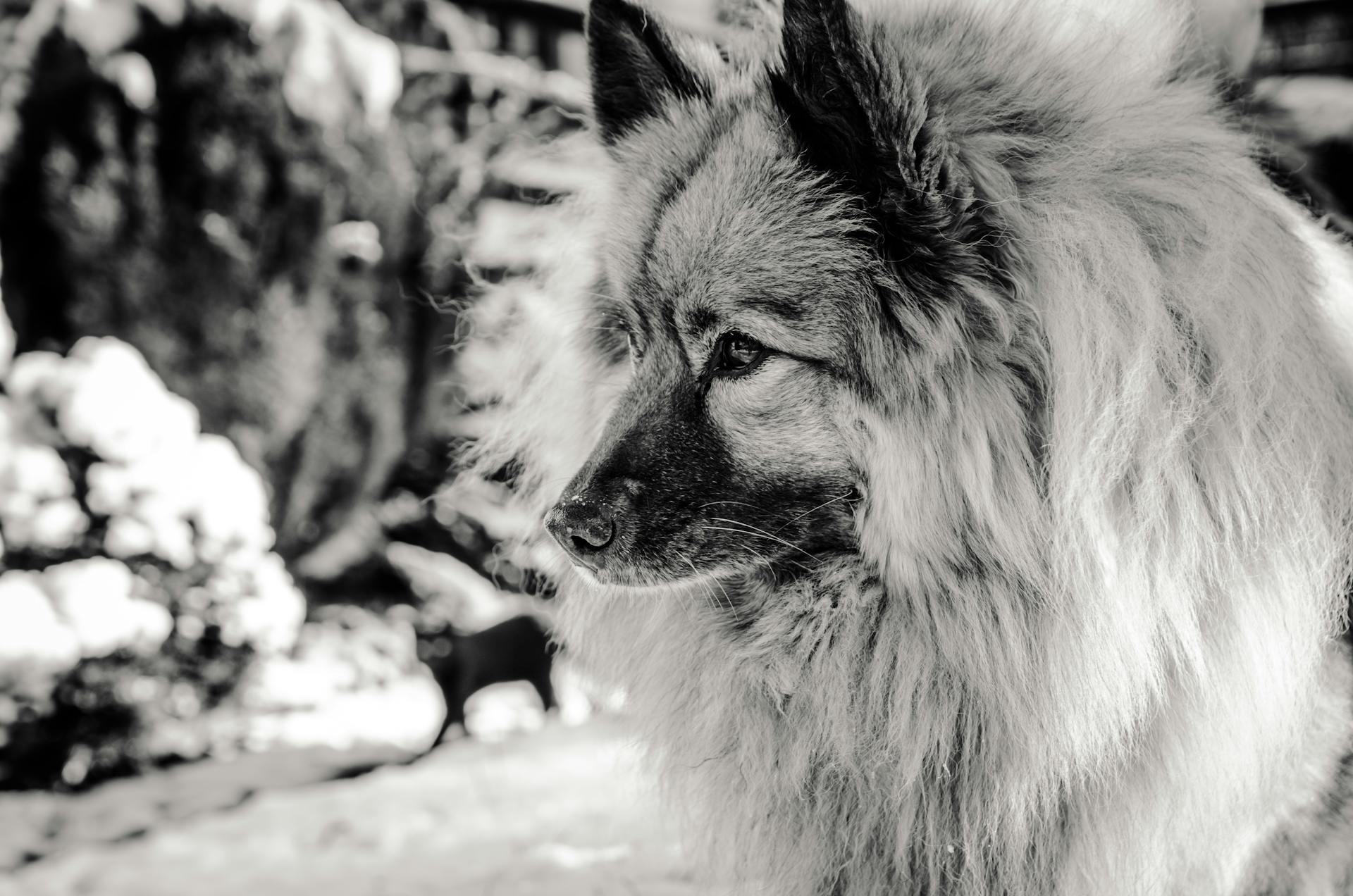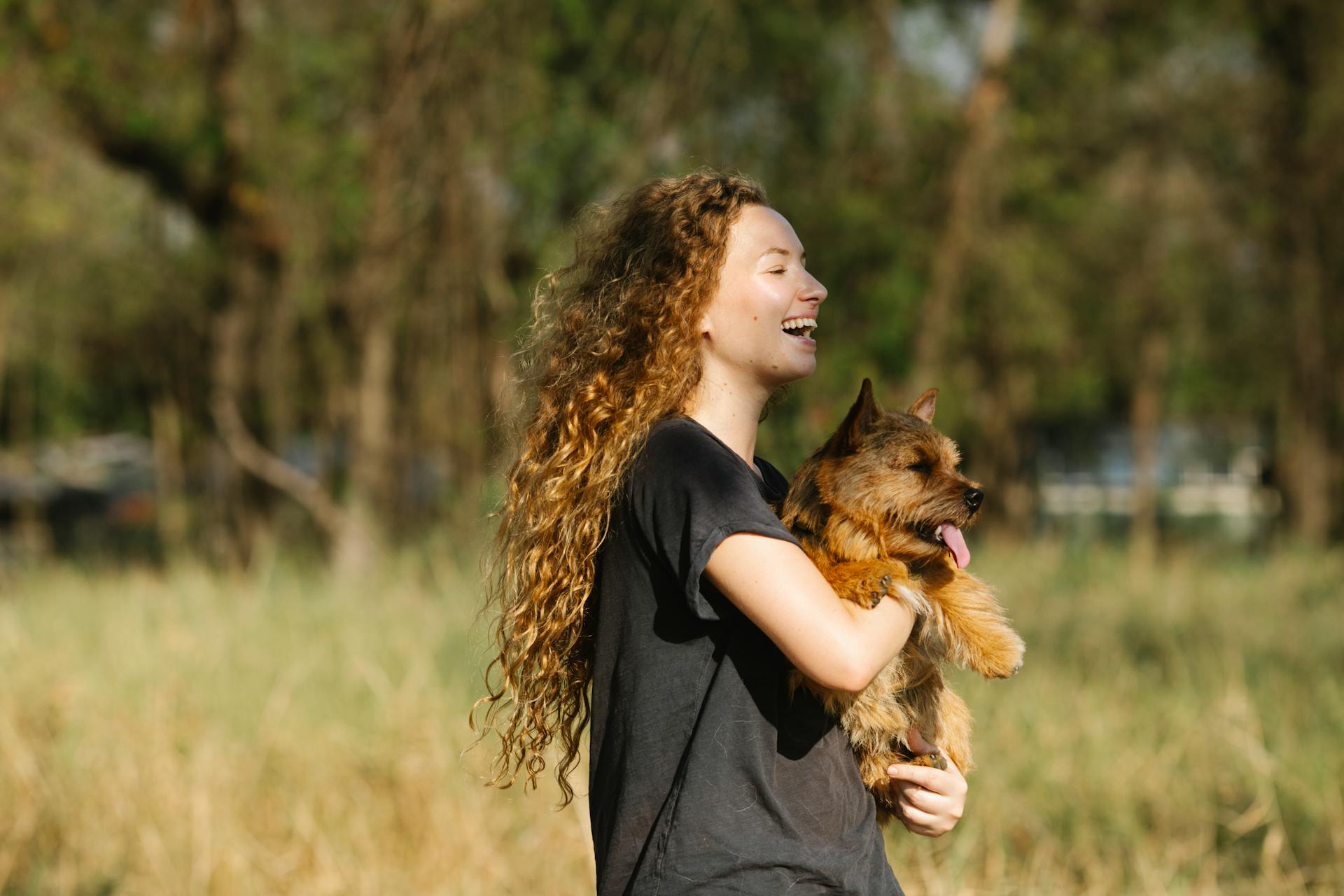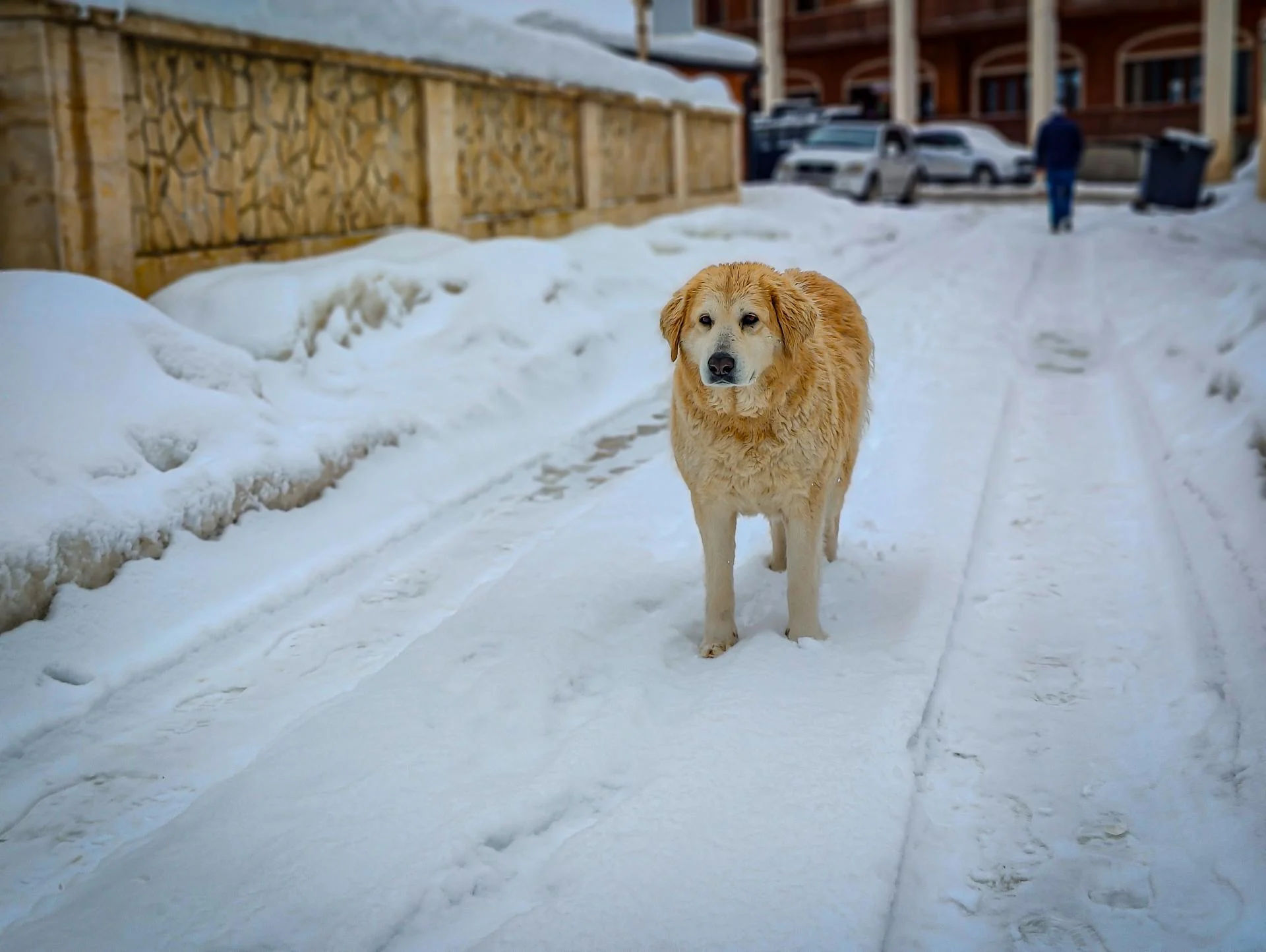
The Great Pyrenees is a majestic breed, but as an adult, they can grow quite large. Adult Great Pyrenees typically weigh between 85 and 115 pounds.
Their size can be a challenge, especially for owners with small living spaces. However, with proper care and attention, they can thrive in a variety of environments.
One of the most significant health concerns for adult Great Pyrenees is hip dysplasia, a genetic condition that affects the hip joint. This can lead to arthritis and mobility issues later in life.
Great Pyrenees are also prone to certain health issues, such as bloat and gastric torsion, which can be life-threatening if not addressed promptly. Regular veterinary check-ups can help identify these issues early on.
Adult Great Pyrenees require regular exercise to stay healthy and happy, with a minimum of 30 minutes of physical activity per day recommended.
You might enjoy: Great Pyrenees Health Problems
General Information
The Great Pyrenees is a large dog with a muscular build, weighing between 85 to 150 pounds.
They're naturally wary and suspicious of strangers, which can make social gatherings a bit challenging.
As a working dog breed, you can expect a faithful worker's personality from your adult Great Pyrenees.
Overview

The Great Pyrenees is a large dog with a muscular build, weighing between 100 to 150 pounds for males and 85 to 120 pounds for females.
These big dogs are naturally wary and suspicious of strangers, which can sometimes challenge visitors when you're in social spaces.
Their thick double coat is a defining feature, with a rough, thick white overcoat and a woolly undercoat that may have markings of gray, tan, badger, or reddish-brown.
The breed is known for its fearless nature, able to fight off attacking wolves and bears, and is also gentle and caring to those it trusts.
You can expect a faithful worker's personality from a Great Pyrenees, which is a testament to their heritage as working dogs.
Their lifespan is relatively short, ranging from 10 to 12 years, which is something to consider if you're thinking of bringing one home.
Despite their size, Great Pyrenees are nimble-footed and have a unique gait that's more about elegance than speed.
History
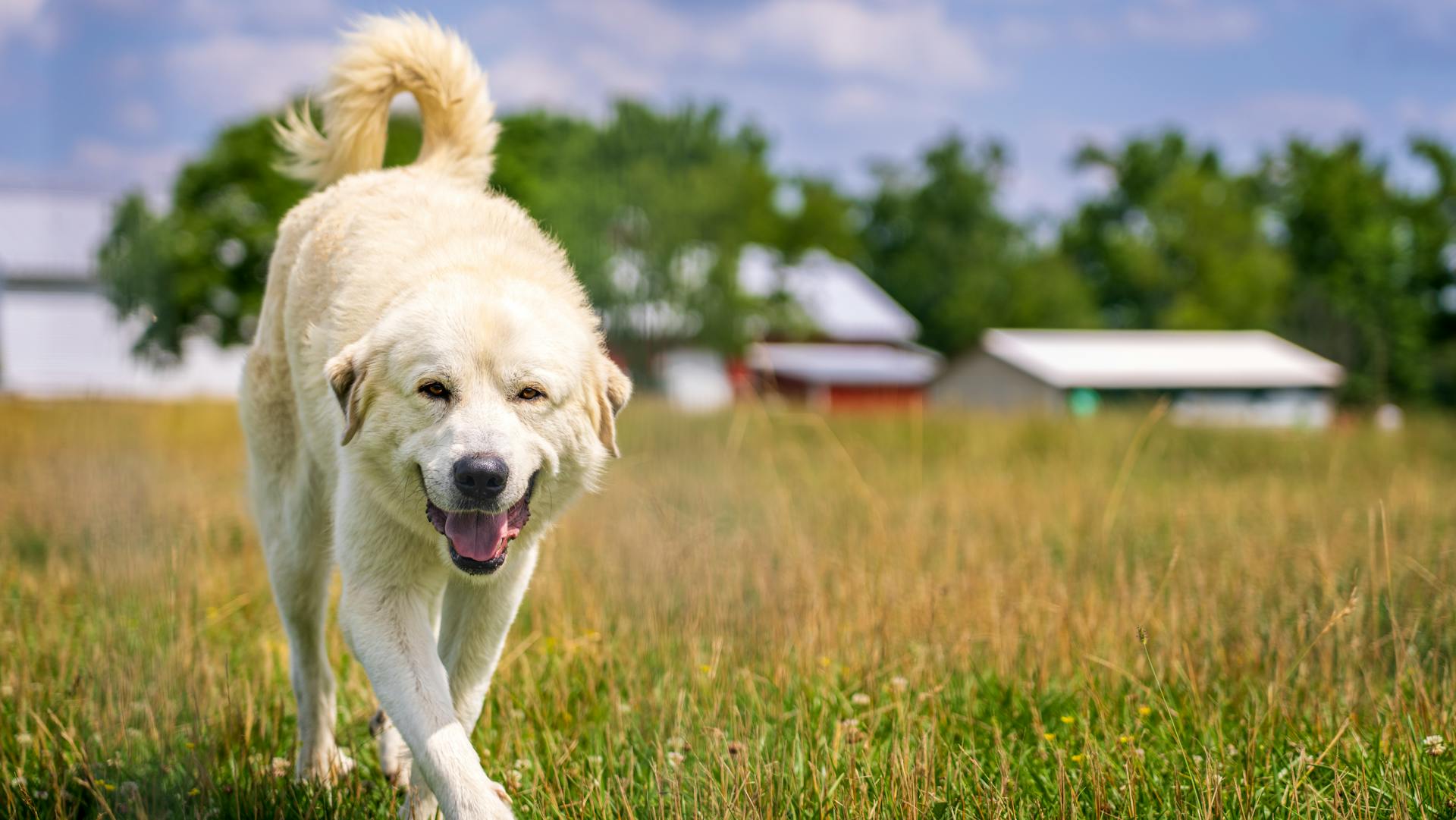
The Great Pyrenees has a rich history dating back to the Pyrenees Mountains, which form a natural border between France and Spain.
The breed originated in Asia Minor around 10,000 to 11,000 years ago, but its ancestors didn't arrive in the Pyrenees Mountains until around 3,000 B.C.
The Great Pyrenees was initially considered a dog owned by peasants, but its status changed in 1675 when the Dauphin in the court of King Louis XIV declared it the Royal Dog of France.
The first Great Pyrenees imported to North America went to Newfoundland, Canada, where the breed is credited with creating the Landseer Newfoundlands after crossbreeding with the Newfoundland.
Throughout the 1800s, the breed gained popularity in England, Europe, and the United States, and was even introduced into the St. Bernard's breeding program in Switzerland.
The two World Wars took a toll on dog breeding, but fortunately, several Great Pyrenees were imported to the United States before the European continent was effectively closed due to World War II.
The breed began to deteriorate in its homeland due to unscrupulous breeding practices, but breeders in the United States worked to restore the breed to its former glory after the war.
Recommended read: Great Pyrenees Standard
Breed Characteristics
The Great Pyrenees is a large dog with a muscular build, weighing between 85 to 150 pounds, depending on the sex. They have a thick double coat and a rough, thick white overcoat with a woolly undercoat.
They are naturally wary and suspicious of strangers, which can make social interactions challenging. However, with proper socialization, they can become friendly and outgoing.
Here are some key characteristics of the Great Pyrenees breed:
They are intelligent dogs, but training can be a lifelong and fun activity, requiring a firm and consistent leader.
Size
The Great Pyrenees is a large dog, with an average height of 27 to 32 inches for a male and 25 to 29 inches for a female.
These dogs can be quite massive, weighing between 100 to 160 pounds for a male and 85 to 115 pounds for a female.
Their muscular build is one of their defining characteristics, making them well-suited for their original purpose as working dogs.
You'll notice their nimble-footed movements, which are often more about agility than speed.
The Great Pyrenees is a giant dog in every sense of the word, with a heart to match their size.
A unique perspective: Great Pyrenees Male vs Female
Mountain Range
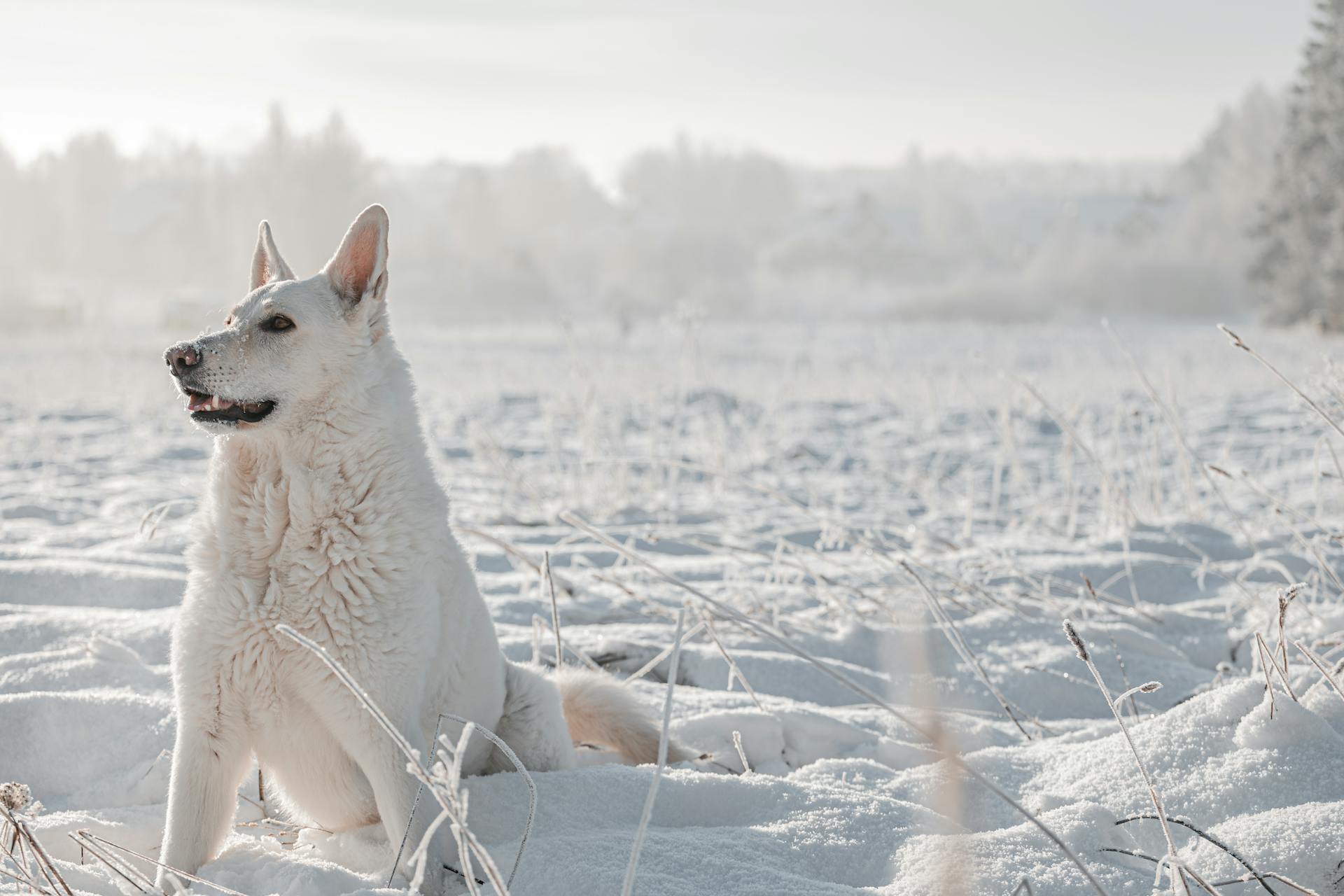
Living in a mountain range can be a great environment for a Great Pyrenees, but it's essential to consider their socialization needs. They require early exposure to many different people, sights, sounds, and experiences to grow into a well-rounded dog.
Socialization is key, and enrolling your Great Pyr in a puppy kindergarten class is a great way to start. Regular visits from friends and family, as well as trips to busy parks and stores that allow dogs, will help them develop good social skills.
A Great Pyrenees is intelligent and independent, but this can sometimes make them stubborn. They need consistent training and socialization to become well-mannered and gentle companions.
Characteristics of the
The Great Pyrenees is a large dog breed with a muscular build, weighing between 85 to 150 pounds, depending on the sex.
One of the standout characteristics of the Great Pyrenees is their thick double coat, which requires regular grooming to prevent matting.
These dogs are naturally wary and suspicious of strangers, making them great watchdogs, but also challenging for visitors when you're in social spaces.
Great Pyrenees are known for their gentle and affectionate nature, making them a great fit for families with children who understand how to interact with dogs.
Despite their size, Great Pyrenees are not highly active dogs and prefer to roam outside, but they do need regular exercise to stay happy and healthy.
Here are some key characteristics of the Great Pyrenees breed:
Great Pyrenees are naturally nocturnal, which means they can get a bit restless at night, barking to alert their family to potential predators or intruders.
With proper socialization and training, Great Pyrenees can make wonderful companions, but they do require a firm and consistent leader to help them stay on track.
Health and Care
Adult Great Pyrenees need to spend plenty of time with the family to prevent boredom and destructive behavior.
Pyrs will benefit from some type of job, such as guarding homes or training for obedience competitions, to channel their strong drive to work and protect.
A physical fence is necessary, as they can ignore an electronic fence due to their thick fur and high pain tolerance, and may try to escape to pursue suspected predators.
Health Conditions
As a Great Pyrenees owner, it's essential to be aware of the potential health issues that can affect your furry friend. Abnormal development of the hip socket can lead to hip dysplasia in Great Pyrenees.
Regular inspections are crucial to catch any discomfort in the joints caused by abnormal cartilage formation. This can be a painful condition for your dog, so keep an eye out for any signs of pain or stiffness.
Inverted eyelids, also known as entropion, can cause irritation and discomfort for your Great Pyrenees. It's essential to check your dog's eyes regularly for any signs of this condition.
You might like: Hip Dysplasia Great Pyrenees
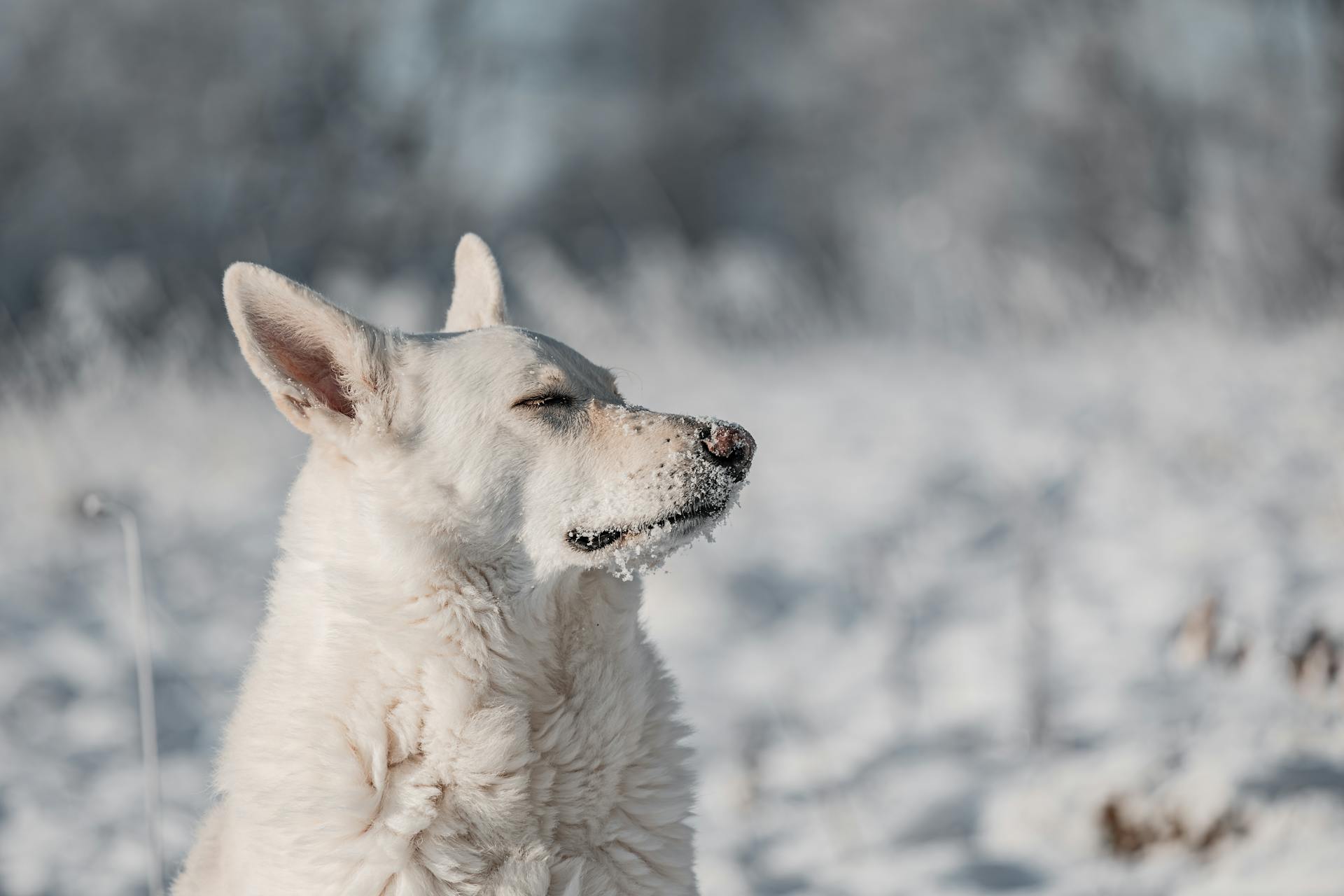
Addison's disease is another health concern that can affect Great Pyrenees. This condition affects the adrenal glands and can cause a range of symptoms, including weight loss, vomiting, and diarrhea.
Here are some common health concerns to look out for in Great Pyrenees:
- Abnormal development of the hip socket (hip dysplasia)
- Discomfort in the joints due to abnormal cartilage formation
- Inverted eyelids (entropion)
- Addison's disease
Gastric Dilatation-Volvulus
Gastric Dilatation-Volvulus is a severe and potentially life-threatening condition that can affect deep-chested breeds like the Great Pyrenees.
The condition occurs when a large amount of food and gas builds up in the stomach, causing increased pressure that can twist and cut off blood flow to the stomach and spleen.
Bloat typically happens when a large amount of food and gas builds up in the stomach.
Immediate veterinary care is crucial if you notice signs of GDV, such as a distended abdomen, retching without producing any vomit, general signs of abdominal pain, and excessive drooling.
A gastropexy surgery, which involves tacking the stomach to the abdominal wall or diaphragm, can help prevent GDV and is often performed when deep-chested dogs are spayed or neutered.
Curious to learn more? Check out: When Do Great Pyrenees Get Their Full Coat
Care

Great Pyrenees are known for their independence, which can make them strong-willed during training. This means they value their alone time and may require more patience and consistency when teaching new behaviors.
They need to spend plenty of time with the family to prevent boredom and destructive behavior. Leaving them outside in the yard when you're not home can lead to escape attempts.
Great Pyrenees are not high-energy dogs, but they do require daily exercise to stay happy and healthy. A minimum of 30 to 40 minutes of walking per day is recommended.
They can adapt to different exercise levels, but two hours of exercise per day is suitable for this breed. They do best with a large, well-fenced yard for roaming and patrolling.
Special care should be taken to prevent overheating during exercise, especially in hot temperatures. They do well exercising in cold weather, however.
A physical fence is necessary, as electronic fences may not be effective due to their thick fur and high pain tolerance.
Here's an interesting read: Great Pyrenees Exercise Needs
Training

Training your Pyrs requires consistency and patience, as they can be independent and stubborn at times. They thrive on positive reinforcement training techniques, which are essential for building a strong bond between you and your dog.
Pyrs are naturally suspicious of newcomers, so socialization from a young age is crucial to help them feel more at ease around strangers. Without proper socialization, they may become overly protective of their family and territory.
You should supervise interactions between children and your Pyrs, as they can be boisterous and may accidentally harm each other. It's also essential to teach your kids how to handle their dog gently and safely.
Readers also liked: How to Train a Great Pyrenees
Diet and Nutrition
Adult Great Pyrenees are easy feeders and can thrive on a high-quality dry dog food. Serve them two meals a day, with the amount of food varying based on their size, activity level, age, and other factors.
You should discuss your dog's individual nutritional needs with your veterinarian to determine the best diet for them. This is especially important for large breeds like the Great Pyrenees, which can be prone to bloat and other health issues.
Discover more: Puppy Food for Great Pyrenees
To prevent overfeeding and obesity, monitor your dog's weight and adjust their food intake accordingly. You can use the "waist test" to check if your dog is overweight: if you can't see their waist, they need less food and more exercise.
A Great Pyrenees can benefit from a brand-formulated dog food for large breeds. To avoid bloat, feed them smaller portions multiple times a day, and use slow-feeder bowls to make them eat more slowly.
Here's a rough guide to the daily food intake for an adult Great Pyrenees:
- 4 to 6 cups of high-quality dry food a day
- Divide into two meals
- Adjust based on size, age, build, metabolism, and activity level
Remember, every dog is different, and their food needs will vary accordingly. Consult with your veterinarian for specific guidance on feeding your adult Great Pyrenees.
Grooming Guide
Great Pyrenees have a majestic white coat with a long outer coat and soft undercoat, making them a low-maintenance breed when it comes to grooming.
Weekly brushing is sufficient to keep their coat in good condition, and a 30-minute brushing session is enough to keep their coat looking its best.
Check this out: Great Pyrenees Coat Colors
Their silky outer fur tends to be resistant to tangles and dirt, which lessens the grooming requirements for this breed.
However, Great Pyrenees are heavy shedders, and more frequent grooming can help pet parents stay on top of the flying fur.
You'll still need to bathe your dog once every couple of months, but their coat naturally sheds dirt, so you won't need to bathe them too often.
Trimming your dog's nails is a must to keep them from splitting, and trimming can also reduce the risk of scratches from their gentle pawing.
Brushing your dog's teeth at least a couple of times per week can help prevent gum disease, and checking their ears weekly for dirt, wax buildup, and other abnormalities is a good habit to get into.
For your interest: Great Pyrenees Matted Fur
Rescue and Ownership
If you're considering adopting an adult Great Pyrenees, it's essential to understand the unique needs of this breed.
Great Pyrenees are often acquired without any clear understanding of what goes into owning one, and these dogs often end up in the care of rescue groups, needing adoption or fostering.
You can start your search for an adult Great Pyrenees through reputable rescue groups, such as National Pyr Rescue, Great Pyrenees Club of America Rescue, Great Pyrenees Association of Southern California Rescue, or Great Pyrenees Rescue of Greater Chicago.
These rescue groups can provide you with valuable information about the breed and help you find a Great Pyrenees that's a great match for your lifestyle.
Broaden your view: Great Pyrenees Rescue in Nc
Rescue Groups
If you're considering adopting a Great Pyrenees, it's essential to start with a rescue group. Great Pyrenees are often acquired without understanding what goes into owning one, and these dogs often end up in the care of rescue groups, needing adoption or fostering.
If you're interested in adopting a Pyr, a Great Pyrenees rescue group is a good place to start. You can find reputable rescue groups through organizations like the National Pyr Rescue or the Great Pyrenees Club of America Rescue.
Some notable rescue groups include the Great Pyrenees Association of Southern California Rescue and the Great Pyrenees Rescue of Greater Chicago. These organizations work tirelessly to find forever homes for these magnificent dogs.
Here are some reputable Great Pyrenees rescue groups to consider:
- National Pyr Rescue
- Great Pyrenees Club of America Rescue
- Great Pyrenees Association of Southern California Rescue
- Great Pyrenees Rescue of Greater Chicago
Other Pets
The Great Pyrenees is a gentle giant, but it's essential to remember that it's still a large dog. A well-socialized Pyr tends to get along with other dogs.
If you have young children, it's crucial to supervise interactions between the dog and kids. Teach your child never to approach any dog while it's eating or sleeping or to try to take the dog's food away.
The Great Pyr does well with other animals in the house, especially if it's been raised with them from puppyhood.
Frequently Asked Questions
Do Great Pyrenees make good family dogs?
Yes, Great Pyrenees can make good family dogs for experienced families, but they require supervision around young children due to their large size and powerful build. They're a great fit for families with older kids who can understand and respect their gentle giant nature.
Are Great Pyrenees clingy?
Great Pyrenees are highly social dogs that require constant companionship and affection, and can become destructive if left alone for extended periods. They need regular interaction and attention to thrive, making them a great fit for families or owners who can provide the necessary attention.
Sources
- https://dogsbestlife.com/dog-breeds/great-pyrenees/
- https://dogtime.com/dog-breeds/great-pyrenees
- https://www.petmd.com/dog/breeds/great-pyrenees
- https://www.thesprucepets.com/breed-profile-great-pyrenees-1117970
- https://www.hannaheliseschultz.com/blog/7-things-to-know-before-getting-a-great-pyrenees-amp-an-introduction-to-winnie
Featured Images: pexels.com
